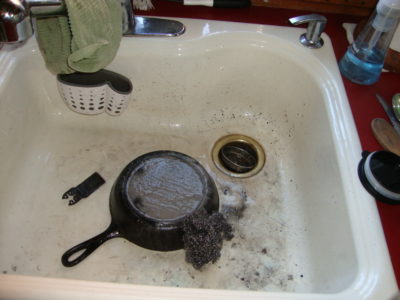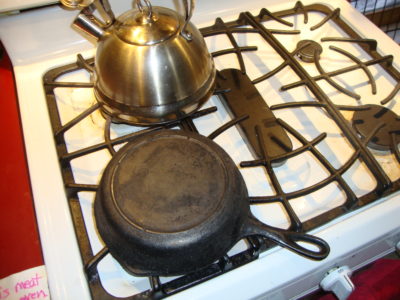When Bethann and I got married in 1975, we received Corning Ware Centura dishes with matching cookware that was supposed to be unbreakable, oven to freezer to microwave, last forever. We had four daughters, worked full time, rehabbed a couple of houses we were living in; exercised radical and exuberant hospitality and disproved that theory, or whatever it was. When those unbreakable pans hit the floor and broke, they shattered with panache! (Let it sink in. … OK … now ,,, both parts? groan? Thanks.)
So we replaced the dishes with cheap apple stoneware dishes for years. They take up too much room in our limited cupboards in our current old house, so we bought speckled enamel tinware in Amish country for our everyday plates. We can fit so many in our cupboards, we don’t need paper plates any more for parties. That’s right, the post is about skillets!
Back in 1975, we were given a set of three cast iron skillets. We have probably used at least one of them almost every day since. That set cost far less than a placesetting of our CenturaWare® or than one Corning® pan. Cast iron is superior to Teflon® for several reasons, the most significant of which is the production of it does not poison seals at the North Pole. If we had been given Teflon® pans, we wouldn’t be talking about them now. They would be long gone. Any bits we would have ingested would have been carcinogenic; whereas bits of cast iron pans are iron, which most people need in their diet.
Cast iron skillets take some basic maintenance. We wash them with hot water and steel wool. Then we put them on the stove with the flame on low to dry. Occasionally, if it looks too dry, we put a little olive oil in it while it is still hot and rub it around evenly with a clean rag or paper towel to re-season it.
After 40 years of use, your pan may look like this:

It was time to take action to restore this skillet, so it could continue to serve for another 40 years. It was simple, I took a spent oscillating cutter tool blade and scraped the accumulated charred crud off the bottom and outsides of the pan. Then I scrubbed it with steel wool and rinsed and repeated. Then I finished by scouring the bottom and outsides with comet and hot water with steel wool and rinsing thoroughly.


Now it should take less energy to heat and cook. It will distribute heat more evenly, like when it was new. So mark your calendars to do your 40 year maintenance on all your cast iron skillets. It works the same way for Dutch Ovens, too. With them, you could probably get away with 50 years, as there isn’t so much stovetop use.
This was one of my “sidetracks” from home repairs. I get in the mode of fixing things, then that mode sort of generalizes in me. I get sidetracked onto these little projects as breaks from the bigger ones. Not to worry, I did manage to finish replacing the fan in the upstairs bathroom.
I work on these projects and write about them to combat my severe depressive disorder and cPTSD. Maybe you will find something helpful.

